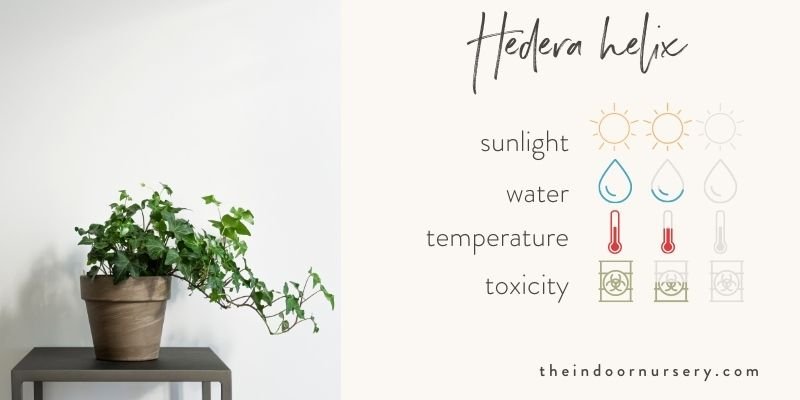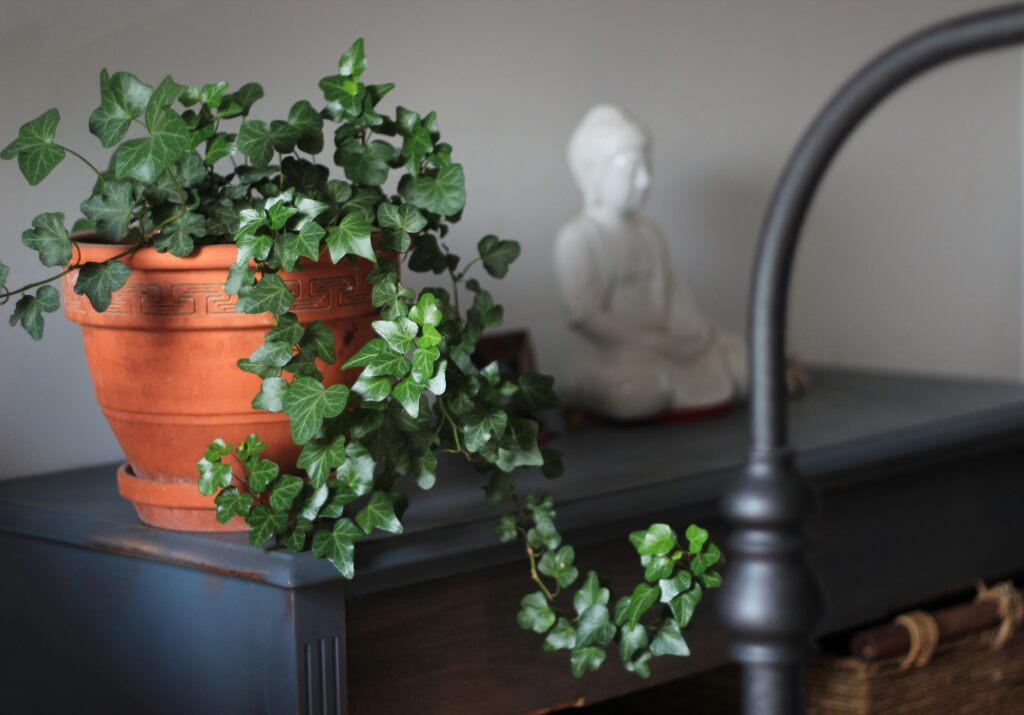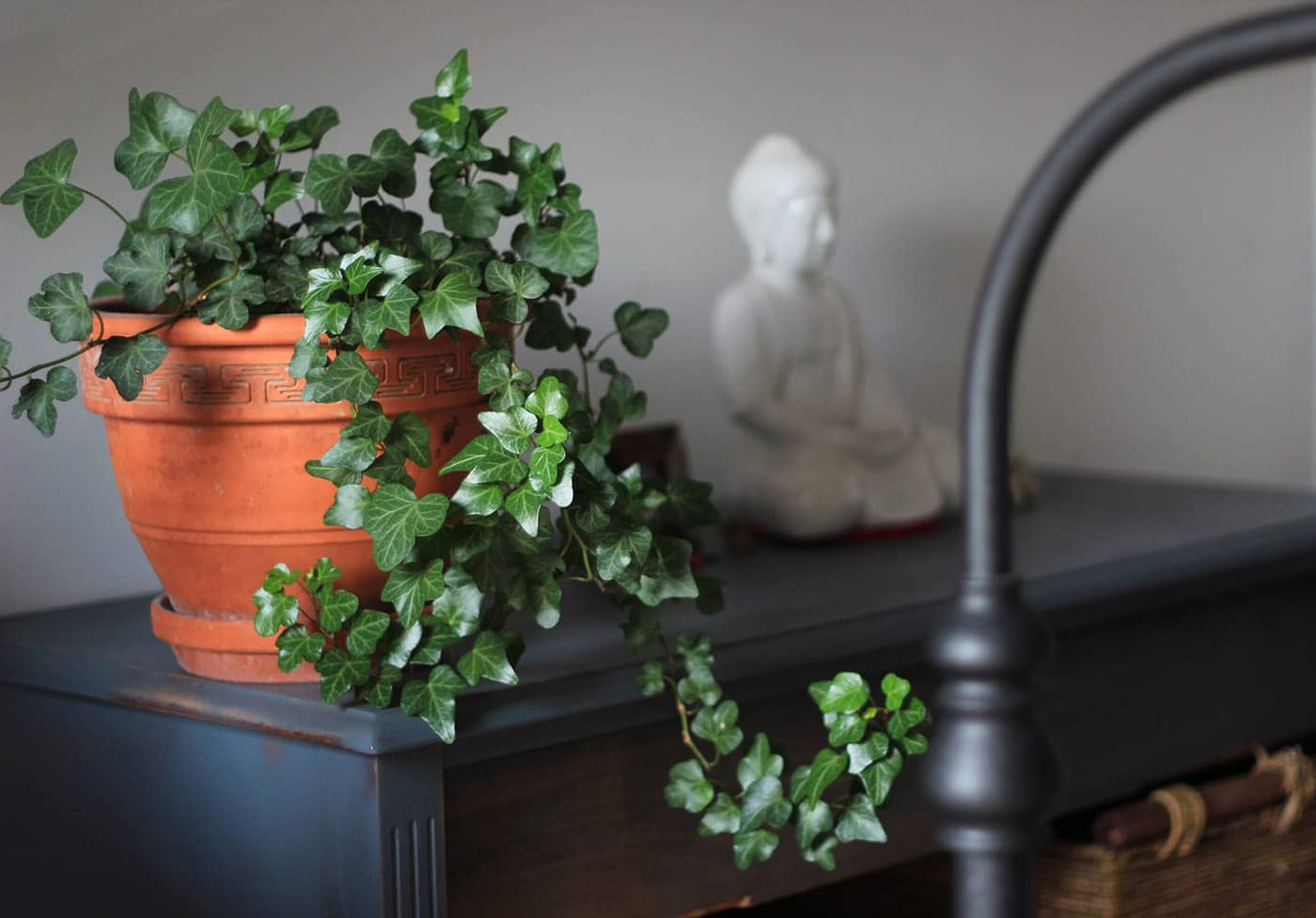plant description
The English Ivy plant is a common houseplant with a woody vine structure and leathery, lobed leaves ranging in shades from dark-green to jade, with yellow and white markings in variegated species. English Ivy is famously fast-growing and considered invasive in many parts of the world due to its vigor when left to grow outdoors un-checked. As an ornamental plant, English Ivy is loved for its ability to warm just about any living space with leafy ambience from balconies to brick walls.
English Ivy is a super climber that grows aerial roots to grow and cling to objects. Outdoors, it’s commonly used as ground cover. English Ivy can climb to heights of 80 feet, and will strangle out trees, bushes, and anything growing in its path. Indoors, English Ivy has become a popular choice to grow in hanging baskets, tie to trellises, or stake against room dividers and architectural elements for growing upwards in vertical space.
plant facts
| common name | Common Ivy, European Ivy, Bindwood, Lovestone, Ivy Gum Plant |
| botanical name | Hedera helix |
| no. of species | about 15 |
| family | Araliaceae |
| biological life cycle | perennial |
| foliage | evergreen |
| mature size | can climb 25-40 feet, growing to a spread of 8-13 feet |
| time to maturity | 1-2 years without pruning – will remain in the juvenile form with pruning |
| origin | Europe and Western Asia |
| light conditions | bright, indirect light |
| soil type | well-draining, aerated and rich soil |
| soil pH | neutral to slightly alkaline |
| USDA Zone | 4-9 |
| toxicity | mildly toxic to humans and pets |
Do some research before planting English Ivy outdoors. In many areas, experts advise against this to protect native species that English Ivy tends to choke out. Not to be confused with Poison Ivy, English Ivy is, however, mildly toxic and can cause irritation on contact with skin and upon ingestion. Keep away from pets!
popular varieties
There are many cultivars of the English Ivy species. One of the most popular is Goldchild, which is a variegated ivy rimmed and marbled in shades of gray-green and yellow. Two other popular varieties are Needlepoint English Ivy, which is known for its dramatic, long-lobed leaves, and Glacier English Ivy, a variegated ivy with gray-green leaves and silver striations.
Other common types of ivy include
- Algerian Ivy (Hedera Algeriensis),
- Himalayan Ivy (Hedera Nepalensis),
- Persian Ivy (Hedera Colchica),
- and Atlantic Ivy (Hedera Hibernica).
how to take care of english ivy

light 🔆
Best light: bright, indirect light
English Ivy prefers bright, indirect light when growing inside. It can tolerate medium to low light, and even partial shade to full shade. In lower light conditions, variegation may become more pronounced and plant growth will slow.
water 💧
Water needs: water thoroughly when top-half inch of soil is dry
Common Ivy should be watered thoroughly, 1-2 times per week in its growing season (spring to fall). Allow the top half-inch of soil to dry out fully before watering again.
If the ivy is recently propagated, the plant should have more moisture. Ivy can handle drier conditions once it has developed a strong root system.
humidity 🌫️
A moderate to high humidity, around 40%, is preferable for ivy. English Ivy can tolerate lower humidity levels, though this is not preferred.
To increase humidity in the environment, mist the plant frequently. Use a pebble tray with water or a humidifier if you live in a dry climate!
temperature 🌡️
English Ivy can grow in a wide range of temperatures, generally from 45°F (7°) to 80°F (27°). Despite its vigor, English Ivy does not tolerate freezing temperatures well.

fertilizer 💩
English Ivy can be fertilized once a month during the growing period from spring to fall with a nitrogen-rich fertilizer.
Do not fertilize English Ivy during the winter when the plant is nearing dormancy. Fertilizing in the late fall might extend its growth period temporarily, but might result in damage to new shoots. Abstain from fertilizing English Ivy when the plant is in stress due to a drastic temperature or soil change or over-pruning.
soil 🪨
The Hedera Helix prefers well-draining, aerated, and rich soil. The soil can be amended with compost. Covering the topsoil with a layer of mulch will help the soil to retain moisture in dry air environments.
Don’t worry too much about this guy though! English Ivy is a super durable plant, and it is often content to grow in whatever soil you might have on hand.
Any soil PH will suit English Ivy, though neutral to slightly alkaline is preferable.
Soil Type: well-draining, aerated, rich
pH level: neutral to slightly alkaline
repotting 🪴
As a rapidly-growing plant, juvenile English ivy plants should be repotted yearly. Adult plants should be repotted every two or so years. Watch for roots emerging from drainage holes and soil that seems to dry out very quickly after watering – these are two common signs that your happy camper needs repotting!
When repotting, use a pot that is only slightly larger in diameter than the old pot. Add fresh potting soil to reduce the risk of pests and flush your ivy with nutrients.
propagation 🌱
The Hedera Helix is commonly and easily propagated through stem cuttings. Cut a healthy section of new-growth (the light green sections are best) around 4-5 inches in length and place the cut end into water. Keep the cutting in a warm, well-lit place. New roots will begin to grow from the cut end in around 3 weeks. Once the roots are around 4 inches in length, transplant the cutting into a small, well-draining pot. Rooting hormone is not necessary for propagation, but it can help increase the odds of successful new growth.

pruning 🌿
Pruning is necessary to prevent English Ivy from taking over your home! Prune in spring before heavy growth to shape the plant and stimulate bushy foliage growth.
Wear gloves and long sleeves when pruning to prevent skin irritation. To prune, clip trailing vines down to the leaf node closest to your desired length.
pests and diseases 🐛
Pests: aphids, spider mite, mealybug, scale
Disease: Bacterial leaf spot
The English Ivy plant is susceptible to aphids, spider mite, mealybug, and scale. However, Ivy can be easily treated with insecticidal soap or neem oil.
Bacterial leaf spot is a common disease that English Ivy is prone to. Two common treatment options for this troublesome disease are to remove the infected leaves, or use a mix of soap, water, and baking soda to prevent further infection. Leaf removal is recommended for mature plants.
plant care tips
- Although ivy does not need guidance to grow on a trellis or stake, it can be trained and shaped as a climbing vine to fit any indoor space. This plant’s aerial roots can cling to almost anything! Perch a pot of English Ivy on top of a kitchen cabinet or wardrobe, and allow the vines to drape as a tasteful room accent.
Common Problems / FAQs:
Yellowing leaves, black stems, wet potting mix, root rot
-> It’s possible the soil is not well-draining or that the pot is retaining water. Ensure that the soil is draining well, and that it is only being watered when the top layer is completely dry. If the ivy already has root rot, remove the infected area with clean garden shears and repot the healthy plant in new potting mix.
Shop our recommendations
- The Best Hydroponic Tower For Indoor Gardening
- 10 Best Worm Composter Bins For Easy Homemade Compost
- The Best pH Meter For Soil
- The 6 Best Dehumidifiers For Grow Tents
- The Best Complete Indoor Hydroponic Grow System
- 5 Best Grow Light Strips For Indoor Plants
- TESTED: Aerogarden vs Click and Grow Smart Garden
- Our *hands on* MARS HYDRO TSW 2000 review (with photos)
- 7 Best Hygrometers For Indoor Plants
- The Best Coco Coir For Your Plant’s Healthiest Root System Ever



Hey, Marcia! Thanks for reading :) gosh, that's a great idea to double up on your watering globe and spike.…